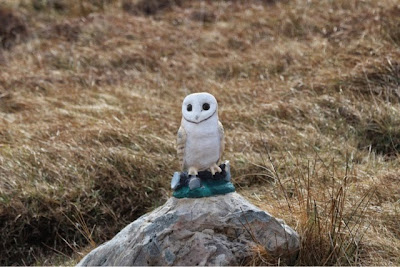Our last full day on Orkney, at least for this trip, and what did we do? Passed through Kirkwall on our way to South Ronaldsay, the southernmost of the islands linked via causeways, to visit the Hoxa Tapestry Gallery. Thence to Deerness to the Sheila Fleet jewellery 'factory', finishing up with a 4 mile walk on the cliffs around Mull Head. All in all, another good day, with nary a drop of rain. As ever, a few photographs for illustrative purposes:
1. Boats and lines in Kirkwall harbour.
2. The natural anchorage of Scapa Flow was thought, at one time, to be pretty well impregnable. Until, that is, a night during WW1 when a German U-boat slipped in through one of the narrow inlets and sank a warship. After this more attention was paid to security. The photograph shows the remains of a 'block ship' that was sunk in one of the inlets, forming an effective barrier to any large vessel wanting to enter.
3. At the beginning of WW2 the defences of the inlets were deemed to be inadequate and Churchill had something more substantial built. These 'Churchill barriers', of which there are four, were built of huge amounts of rock and rubble infill, finished off with 5 and 10 ton concrete blocks. The random placement of the 5 ton blocks helps reduce the effect of waves upon the barrier. All the barriers have a 'proper' road going over the top of them and now it is possible to drive all the way to the tip of South Ronaldsay. A little like the Florida Keys really.
4. Another rare Orkney bird - this one is the Concrete Footed Owl. It doesn't fly about a lot but when it does, you are advised to duck.
5. St Margaret's Hope on the shores of Scapa Flow. Another day when the sea was calm.
6. A slightly out-of-focus Ringed Plover. Described in one guide I read as a 'stout' bird, this one certainly looks rather rotund. Too much snacking between meals?
7. During WW2, Italian POWs, captured at Tobruk of all places, were detained in a large camp on Burray Island. They were 'employed' casting the concrete blocks used for the barriers. Their imprisonment wasn't too strict and they were allowed to use two Nissen huts in their camp for a chapel. It is richly painted on the inside and still visited by those detained there, and their descendants. Since our previous visit, in 2012, renovation/conservation has obviously been conducted on the murals and it is now looking much fresher and brighter. An unusual thing to come across.
8. An obliging Wheatear - which is a corruption of White Rear as this is what you usually see of them as they fly away from you.
9. Cliffs on our walk around Mull Head. Lots of fulmars nesting with a few gulls and kittiwakes.
10. More cliffs and in the far distance are some of the other Orcadian Islands. This view is typical of that which accompanied us all the way around Mull Head.
11. I was pleased to get this shot of a Great Skua, known in the vernacular of the islands as a Bonxie. And, because of its aggressive behaviour and general nastiness towards anything smaller than itself, it is also known the 'pirate of the skies'. It's top of the food chain and will tackle anything lower down. Here's a bit of trivia for word lovers: skua comes from the Faroese word 'skuvur'. And that's the sum total of my Faroese vocabulary and, I suspect, yours as well.
12. On our 'inward' bound leg of the walk looking west. In the distance can be seen the Covenanters' Memorial at Deerness. Covenanters? Never heard of them? Then I'll enlighten you. Briefly, they were Scottish Presbyterians who objected to the imposition of the Anglican Church on Scotland by the Stuarts. Around 250 of them were being transported in December 1679 to Jamaica, to work as slaves, on the sailing vessel The Crown of London. This got caught up in a storm and was driven onto the rocks where, despite the crew being saved, most of the Covenanters on board were drowned. Being locked below decks by the captain somewhat hampered their ability to escape. The memorial stone was erected in recognition of their plight.
13. A Greylag Goose which is a goose with pink legs and a red beak. Not to be confused with the rarer Pink Legged Goose which has pink legs and a beak with a red tip. So now you know.
14. And with the sun setting in the west over Hoy, we say farewell to Orkney, but not for too long as we hope to return in the summer.














No comments:
Post a Comment